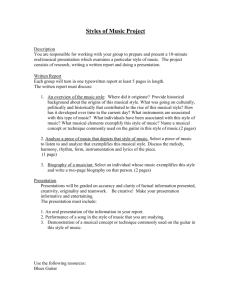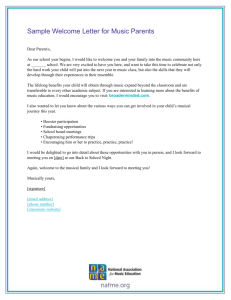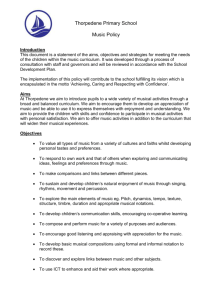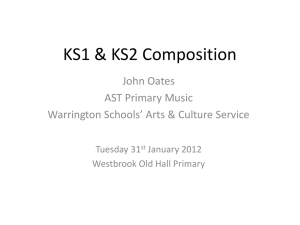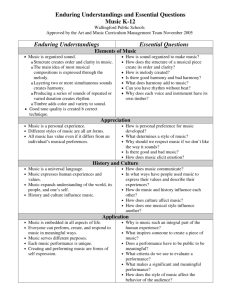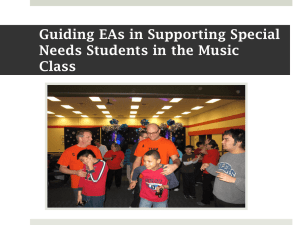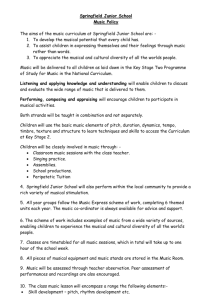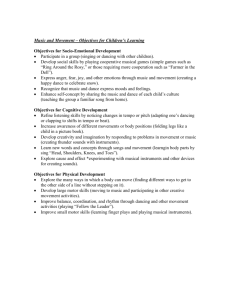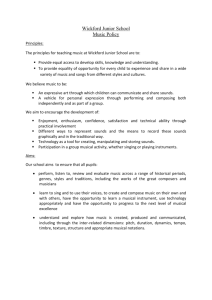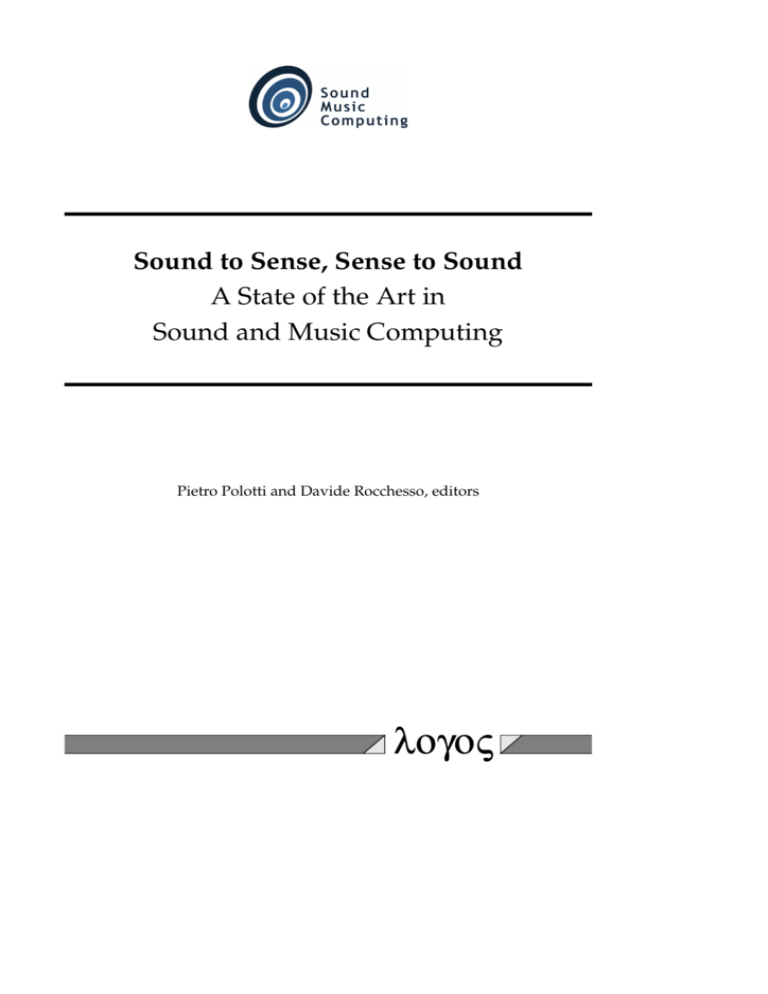
Sound to Sense, Sense to Sound
A State of the Art in
Sound and Music Computing
Pietro Polotti and Davide Rocchesso, editors
Pietro Polotti and Davide Rocchesso (Editors)
Dipartimento delle Arti e del Disegno Industriale
Università IUAV di Venezia
Dorsoduro 2206
30123 Venezia, Italia
This book has been developed within the Coordination Action S2S2 (Sound to
Sense, Sense to Sound) of the 6th Framework Programme - IST Future and
Emerging Technologies: http://www.soundandmusiccomputing.org/
The Deutsche Nationalbibliothek lists this publication in the Deutsche
Nationalbibliografie; detailed bibliographic data are available in the Internet
at http://dnb.d-nb.de.
©Copyright Logos Verlag Berlin GmbH 2008
All rights reserved.
ISBN 978-3-8325-1600-0
Logos Verlag Berlin GmbH
Comeniushof, Gubener Str. 47,
10243 Berlin
Tel.: +49 (0)30 42 85 10 90
Fax: +49 (0)30 42 85 10 92
INTERNET: http://www.logos-verlag.de
Appendix
A
Controlling Sound Production
Roberto Bresin and Kjetil Falkenberg Hansen
Department of Speech, Music and Hearing, KTH, Stockholm
Matti Karjalainen, Teemu Mäki-Patola, Aki Kanerva, and Antti Huovilainen
Laboratory of Acoustics and Audio Signal Processing, Helsinki University of
Technology
Sergi Jordà, Martin Kaltenbrunner, Günter Geiger, Ross Bencina
Music Technology Group, University Pompeu Fabra, Barcelona
Amalia de Götzen1 and Davide Rocchesso2
1
Department of Information Engineering, University of Padua
2
Department of Art and Industrial Design, IUAV University of Venice
Introduction
This appendix is a collection of five contributions by different authors. Each
contribution is self-contained and can be read separately. The scope ranges
from new musical instruments to sonification of interactive books. The ap-
448
Chapter A. Controlling Sound Production
pendix starts with an introductory section, in which general concepts and
problems related to sound control are presented. The authors outline the important issue of the choice of sound models that can provide suitable and
responsive feedback in continuous control, as in the case of sound generated
by body motion and sound as feedback in interaction. In the following sections, some recent and successful applications are illustrated. The first two,
DJ Scratching and Virtual Air Guitar, focus on the control of virtual musical
instruments, and in particular on control that generates sense through sound
production. The last two sections, The reacTable and The Interactive Book,
focus on the control of sounding objects, and are characterised by applications
that control sounds that produce sense. The section sequence can also be
seen as ordered according to an increasing level of sound model abstraction
(from sampled sounds to cartoon sounds) and decreasing level of complexity
of control gesture (from DJ scratching to simple sliding).
The authors of the different sections are:
A.1 Introduction
Roberto Bresin and Davide Rocchesso
A.2 DJ scratching with Skipproof
Kjetil Falkenberg Hansen and Roberto Bresin
A.3 Virtual air guitar
Matti Karjalainen, Teemu Mäki-Patola, Aki Kanerva, and Antti Huovilainen
A.4 The reacTable*
Sergi Jordà, Martin Kaltenbrunner, Günter Geiger, Ross Bencina
A.5 The interactive book
Amalia de Götzen and Davide Rocchesso
A.1. Background
449
A.1 Background
1
There are a few emerging facts that are conditioning our present approaches
to the study of sound. Sensors of many different kinds are available at low
cost and they can be organised into networks. Computing power is generously available even in tiny and low-power processors that can be easily
embedded into artefacts of different nature and size. New design strategies
that take advantage of these technological opportunities are emerging: physical computing, natural interaction, calm technologies are some of the many
buzzwords that are being proposed as labels for these new trends in design.
For the purpose of sound-based communication, the concept of embodied
interaction (Dourish, 2001) is particularly significant. Embodiment is considered a property of how actions are performed with or through artefacts, thus
embracing the position that treats meanings as inextricably present in the actions between people, objects, and the environment. A key observation that
emerges from embodied interaction examples is that human interaction in the
world is essentially continuous and it relies on a complex network of continuous feedback signals. This is significantly important if one considers that
most interfaces to technological artefacts that are currently being produced
are developed around switches, menus, buttons, and other discrete devices.
The design of graphical user interfaces has been largely inspired by ecological
psychology and concepts such as direct perception and affordances (Gibson,
1979). When designing embodied interfaces, we call for a reconciliation of
ecological psychology and phenomenology that looks, with equal emphasis,
at the objects and at the experiences. By means of physical modelling we
can represent and understand the objects. By direct observation we can tell
what are the relevant phenomena, which physical components are crucial for
perception, what degree of simplification can be perceptually tolerated when
modelling the physical reality. Specifically, sound designers are shifting their
attention from sound objects to sounding objects, in some way getting back
to the sources of acoustic vibrations, in a sort of ideal continuity with the experimenters of the early twentieth century, especially futurists such as Luigi
1
Parts of this section are extracted and modified from a recent work by Rocchesso and
Bresin (2007)
450
Chapter A. Controlling Sound Production
Russolo and his intonarumori. In the contemporary world, sounding objects
should be defined as sounds in action, intimately attached to artefacts, and
dynamically responsive to continuous manipulations. As opposed to this embodied notion of sound, consider an instrument that came shortly after the
intonarumori, the theremin invented 1919 by Lev Termen. It is played by
moving the hands in space, near two antennae controlling amplitude and frequency of an oscillator. Its sound is ethereal and seems to come from the outer
space. This is probably why it has been chosen in the soundtracks of some
science-fiction movies (see the documentary by Martin, 2001). Even though
relying on continuous control and display, the lack of physical contact may
still qualify the theremin as a schizophonic artefact, and it is not by coincidence that it is the only musical instrument invented in the twentieth century
(the schizophonic age) that was used by several composers and virtuosi. Indeed, nephews of the theremin can be found in several recent works of art and
technology making use of sophisticated sensors and displays, where physical
causality is not mediated by physical objects, and the resulting interaction is
pervaded by a sense of disembodiment.
A.1.1 Sound and motion
Sounds are intimately related to motion, as they are usually the result of actions, such as body gestures (e.g. the singing voice) or mechanical movements
(e.g. the sound of train wheels on rails). In the same way as we are very accurate in recognizing the animate character of visual motion only from a few light
points corresponding to the head and the major limb-joints of a moving person
(Johansson, 1973), we are very sensitive to the fluctuations of auditory events
in the time-frequency plane, so that we can easily discriminate walking from
running (Bresin and Dahl, 2003) or even successfully guess gender of a person
walking (Li et al., 1991). It is not a surprise that gestures are so tightly related
with sound and music communication. A paradigmatic case is that of the
singing voice, which is directly produced by body movements (see also Chapters 6.3 and 7 for overviews on gestures in music performance). In general,
gestures allow expressive control in sound production. Another example is
DJ scratching, where complex gestures on the vinyl and on the cross-fader are
A.1. Background
451
used for achieving expressive transformation of prerecorded sounds (Hansen
and Bresin, 2004). In the context of embodied interfaces, where manipulation
is mostly continuous, it is therefore important to build a gesture interpretation
layer, capable to extract the expressive content of human continuous actions,
such as those occurring as preparatory movements for strokes (see Dahl, 2004).
Body movements preceding the sound production give information about the
intentions of the user, smoother and slower movements produce softer sounds,
while faster and sudden movements are associated to louder sounds. Gestures
and their corresponding sounds usually occur in time sequences, and it is their
particular time organisation that helps in classifying their nature. Indeed, if
properly organised in time, sound events can communicate a particular meaning. Let us consider the case of walking sounds (Giordano and Bresin, 2006).
The sound of a step in isolation is difficult to identify, while it gives the idea
of walking if repeated a number of times. If the time sequence is organised
according to equations resembling biological motion, then walking sounds can
be perceived as more natural (Bresin and Dahl, 2003). In addition, if sound
level and timing are varied, it is possible to communicate different emotional
intentions with walking sounds. In fact, the organisation in time and sound
level of structurally organised events, such as notes in music performance or
phonemes in speech, can be controlled for communicating different emotional
expressions. For instance in hyper- and hypoarticulated speech (Lindblom,
1990) and in enhanced performance of musical structure (Bresin and Friberg,
2000) the listener recognises the meaning being conveyed as well as the expressive intention on top of it. Research results show that not only we are able to
recognise different emotional intentions used by musicians or speakers (Juslin
and Laukka, 2003) but also we feel these emotions. It has been demonstrated
by psychophysical experiments that people listening to music evoking emotions experience a change in biophysical cues (such as blood pressure, etc.) that
correspond to the feeling of that specific emotion and not only to the recognition. Krumhansl (1997) observed that sad music produced largest changes
in heart rate, blood pressure, skin conductance and temperature, while happy
music produced largest changes in measures of respiration. Music and sound
in general have therefore the power to effect the variation of many physiological parameters in our body. These results could be taken into account in the
452
Chapter A. Controlling Sound Production
design of more engaging applications where sound plays an active role.
A.1.2 Sound and interaction
An important role in any controlling action is played by the feedback received
by the user, which in our case is the sound resulting from the user’s gestures on
an object or a musical instrument. Therefore sound carries information about
the user’s actions. If we extend this concept and consider sounds produced
by any object in the environment we can say that sound is a multidimensional
information carrier and as such can be used by humans for controlling their
actions and reactions relatively to the environmental situation. In particular,
humans are able to extract size, shape, material, distance, speed, and emotional expression from sonic information. These capabilities can be exploited
to use sound as a powerful channel of communication for displaying complex
data. Interactive sonification2 is a new emerging field where sound feedback
is used in a variety of applications including sport, medicine, manufacturing,
and computer games. There are many issues that have been raised in such
applications, and answers are expected to come from interaction design, perception, aesthetics, and sound modelling. For instance, how do we achieve
pleasant and effective navigation, browsing, or sorting of large amount of data
with sounds? In the framework of the Sounding Object project , the concept
of sound cartoonification has been embraced in its wider sense and applied to
the construction of engaging everyday sound models. Simplified and exaggerated models have been proved to be efficient in communicating the properties
of objects in actions, thus being excellent vehicles for informative feedback in
human-artefact communication. For instance, it has been shown that temporal
control of sound events helps in communicating the nature of the sound source
(e.g. a footstep) and the action that is being performed (walking/running). The
possibility of using continuous interaction with sounding objects allows for
expressive control of the sound production and, as a result, to higher engagement, deeper sense of presence, and experiential satisfaction. Low-cost sensors
and recent studies in artificial emotions enable new forms of interaction using
2
See Hunt and Hermann (2005) for a recent overview of the field
A.1. Background
453
previously under-exploited human abilities and sensibilities. For instance, a
cheap webcam is sufficient to capture expressive gesture nuances that, if appropriately interpreted, can be converted into non-visual emotional cues. These
new systems, albeit inexpensive and simple in their components, provide new
challenges to the designer who is called to handle a palette of technologies
spanning diverse interaction modalities. In the future, the field of interaction
design is expected to provide some guidelines and evaluation methods that
will be applicable to artefacts and experiences in all their facets. It is likely
that the classic methods of human-computer interaction will be expanded with
both fine-grained and coarse-grained analysis methods. On a small scale, it is
often necessary to consider detailed trajectories of physical variables in order
to make sense of different strategies used with different interaction modalities.
On a large scale, it is necessary to measure and analyze the global aesthetic
quality of experiences.
A.2. DJ scratching with Skipproof
455
A.2 DJ scratching with Skipproof
A.2.1 Concept
Scratching has been established as a practice of treating the turntable and a
sound mixer as a musical instrument, and is one of the usual DJ playing styles.
Scratching and the related playing style beat juggling require much training for
mastering the complex gesture control of the instrument.
Skipproof, a patch written for pd (Pure Data, Puckette, 1996), is both
a virtual turntable and mixer, and an application for exploring the musical
language of DJs. The name Skipproof is taken from a feature found on DJtools records called a skip proof section, where a sound (or set of sounds) are
exactly one rotation long and repeated for a couple of minutes. If it happens
that the needle jumps during a performance, the chances are quite good it
will land on the same spot on the sound, but in a different groove. The main
purpose is to “scratch” sound files using gesture controllers of different kinds.
Scratch performances are normally built up by the sequential executions
of well-defined hand movements. Combinations of a gesture with the hand
controlling the record and a gesture with the hand controlling the fader3 on the
mixer are called scratch techniques. These have become common language for
DJs, and they refer to them by name (baby, crab, flare) and their characteristics
(1-click flare, 2-click flare, reversed tear). About one hundred techniques were
recognised and more than 20 analysed in previous studies (e.g. Hansen, 2002;
Hansen and Bresin, 2004). The analysis focused on measuring the movement
of the record and the fader. Based on the results, models of synthesised scratch
techniques were constructed.
Originally, the software was intended to be a tool for reproducing and
exploring the modelled scratch techniques with different characteristics. For
instance, we could change speed and extent of the record movements while
maintaining the fader gesture. The graphical user interface allows for easy
experimenting with the models. We decided to develop the patch so it could
3
The crossfader normally has a very short span from silent to full sound, often less than a
millimeter. It is more realistic to consider this fader as a switch than a fader.
456
Chapter A. Controlling Sound Production
be used also for controlling sound files in a turntable-like manner. The user is
not restricted to play sound files, but can control sound synthesis techniques
such as physics-based models. In the end, Skipproof is combining features
from turntable, mixer, vinyl records and modelled DJ performances.
A.2.2 Strategy-implementation
Skipproof most important feature is to allow execution and control of the
scratch technique models, and to do this with customisable interfaces and
controllers. The graphical user interface, made with GrIPD (Sarlo, 2003), serves
as a collection of controllers a DJ normally would expect to find in addition to
new controllers, see Fig. A.1.
All sound samples that are used with the patch are 1.6 seconds long and
looped, reflecting the idea of a skip proof track. The sounds are taken from a
DJ tool record and are all favored for scratching.
There are currently 12 typical scratch techniques ready to use in the
patch. These are models based on analysis of recordings made by a professional
DJ (Hansen, 2002). Each technique consists of a forward–backward movement
of the record and synchronised actions with the fader. Changing the way
a technique is performed is dependent on the controller gesture, and this
connection between gesture and sound output can be customised. When
using several controllers, different mapping schemes will be realised (Hunt
and Kirk, 2000).
In the first version of Skipproof, the techniques can be altered in extent
and speed of the movement, the two most important parameters in scratching
(Hansen and Bresin, 2004). Both extent and speed can be exaggerated, so for
example scratch techniques are performed faster and with larger movements
than in a real situation.
All the elements in the GUI can be accessed by any controller. Until
now, Skipproof has been played by a number of devices, including computer
peripherals and tablets, MIDI devices, Max Mathews’ RadioBaton (Boulanger
and Mathews, 1997) and various sensors (e.g. LaKitchen’s Kroonde and Toaster
A.2. DJ scratching with Skipproof
457
sensor interfaces, Coduys et al., 2004). Among these controllers, the RadioBaton in combination with sliders, buttons, magnetic field, flexion and light
sensors has good potential to be a rewarding interface. Even a computer mouse
in combination with other sensors is quite effective, in contrast to many new
musical interfaces.
Recently, the concept of Skipproof has been successfully implemented
and tested with the reacTable (see Section A.4). Scratch technique models were
assigned to reacTable objects, where one object contained fader movement, one
contained record movement and a third object contained the sound.
A.2.3 Results-expectations
A professional DJ has been using Skipproof in two live concert situations, see
Fig. A.2. The first time, the RadioBaton was controlling the virtual turntable
and technique models. The RadioBaton sticks were replaced with treated
gloves, so the musician could control the turntable speed and the techniques
easily, moving his hand in a 3-D space over the antennae.
In a second concert, the DJ used again the RadioBaton, but now he
could trigger the models based on the hand gesture, as compared to the earlier
version with button triggers. The approach toward a defined area of the
antennae was measured in speed and distance, and this gesture determined
scratch speed and extent. For this performance, a light switch was used to
replace the fader. A light sensor was placed pointing directly toward a lamp,
and the DJ could break the light beam by placing his hand close to the sensor,
or by waving the hand after the light with outstretched fingers. In that way,
controlled and rapid sound on–off events were possible, just like with a fader.
The DJ commented later that although there was a lack of mechanical
feedback from the interface, it opened up to new possibilities. Controlling
recorded techniques was considered to be hard, especially to get the correct
tempo. A scratch DJ uses physical markings on the vinyl (stickers, label) to see
where in a sound the pick-up is, and this feature is moved from the controller
to the GUI in Skipproof. This takes time getting comfortable with and is not
at all optimal.
458
Chapter A. Controlling Sound Production
Users without DJ experience have found the set-up with RadioBaton
as turntable and light switch as fader to be both intuitive and exciting, and
quite fast they could perform with it in a simple fashion. Using the reacTable
(see Section A.4) as the controller interface is a very interesting approach
that addresses the need from non-professional DJs to perform simple scratch
sequences.
DJs seem overall to be interested and intrigued by new technology and
possibilities. It is possible to build a system that enhances DJ performances
of scratching, and it is desirable to experiment with the equipment currently
preferred by DJs. Performing with models of scratch techniques is still a novel
approach that needs to be tested more.
A.2. DJ scratching with Skipproof
459
Figure A.1: Skipproof graphical user interface (left) and synthesised techniques
(right). The GUI contains a combination of standard controllers found on
turntables and mixers, and novel controllers such as technique triggers, visual
representation of sound, sliders for changing control parameters, and more.
The synthesised techniques are saved as sets of two tables; the upper is the
record movement and the lower is the crossfader movement.
460
Chapter A. Controlling Sound Production
Figure A.2: DJ 1210 Jazz scratching with Skipproof in a concert. The RadioBaton is operated with his right hand. Beside the computer screen, there is a
lamp for a light sensor, on the floor, there is a rack of foot switches. The DJ’s
left hand is on the crossfader.
A.3. Virtual air guitar
461
A.3 Virtual air guitar
A.3.1 Concept
A combination of hand-held controllers and a guitar synthesiser with audio
effects is called here the Virtual Air Guitar (VAG). The name refers to playing
an “air guitar”, that is just acting the playing with music playback, while
the term virtual refers to making a playable synthetic instrument. Sensing of
the distance of hands is used for pitch control, the right hand movements for
plucking, and the finger positions may in some cases be used for other features
of sound production. The synthetic guitar algorithm supports electric guitar
sounds, augmented with sound effects and intelligent mapping from playing
gestures to synthesis parameters.
Electronic and computer-based musical instruments are typically developed to be played from keyboard, possibly augmented by foot, breath or other
controllers. In VAG, we have explored the possibility to make an intuitive yet
simple user interface for playing a particular virtual (synthetic) instrument, the
electric guitar. In addition to the synthetic instrument and related audio effects
(amplifier distortion and loudspeaker cabinet simulation) we have explored
three different controllers for player interface: data gloves in a virtual room
environment, special hand-held controller sticks, and webcam-based camera
tracking of player’s hands.
The first case (data glove control) is for flexible experimentation of possible control features, while the two others are intended for maximally simplified
guitar playing, designed for wide audience visiting a science center exhibition.
The two most important parameters needed in all cases are the pitch control
(corresponding to fretting position) and the string plucking action. The pitchrelated information is taken by measuring the distance of the two hands, which
was found easier to use than the distance of left hand to a reference such as
the players body. The string plucking action is most easily captured by the
downward stroke of the right hand.
Here we present an overview of our strategy and implementation of the
virtual air guitar, paying most attention to the user interface aspects from the
462
Chapter A. Controlling Sound Production
players point of view. We then shortly present our results and expectations. A
more detailed description4 of the VAG can be found in Karjalainen et al. (2006).
A.3.2 Strategy-implementation
The VAG system is composed of (1) a guitar synthesiser with sound effects and
audio reproduction, (2) a user interface consisting of handhold sensors, and
(3) software to map user interface signals to expressive VAG playing.
The virtual instrument is a simulation of an electric guitar tuned to
sound like the Fender Stratocaster, and it is realised using the Extended
Karplus-Strong modelling technique described in Karjalainen et al. (1998).
The preamplifier stages of a tube amplifier and loudspeaker cabinet were simulated digitally; the VAG also includes a delay unit and a reverberation unit
integrated with the guitar synthesiser.
For the user interface, we have experimented with three approaches.
1. Data gloves and 3-D position-tracking in a cave-like virtual room (Fig. A.3).
The finger flexure parameters can be mapped to sliding, string damping,
selection of string or chords, or controlling different audio effects.
2. Small handhold control devices (Fig. A.4). The right-hand stick sends
high-frequency pulses via a tiny loudspeaker, and the left-hand stick
receives them via an electret microphone. The pitch is extracted from
the propagation delay of the pulses, whereas the pluck is captured by an
acceleration sensor microchip inside the right-hand stick.
3. Hand tracking by video image analysis (Fig. A.5). The user wears orange
gloves, which correspond to blobs in video frames. A gesture extractor
is informed by their location. A pluck is detected when the right hand
passes through the imaginary guitar centerline. The guitar moves with
the player, and the user’s grip calibrates its size. Vibrato, slide, and string
muting are extractable gestures. The user can choose among two playing
modes: rhythm guitar and solo guitar, i.e. she can strum four different
4
Web documents on the project, including videos of playing the VAG, are available at:
http://airguitar.tml.hut.fi and http://www.acoustics.hut.fi/demos/VAG
A.3. Virtual air guitar
463
power chords, or freely play a guitar solo on a pentatonic minor scale,
with additional techniques such as fret sliding and vibrato.
The VAG’s interface can use complex mapping rules and procedures
from gesture to sound model. This mapping layer is called musical intelligence
in the VAG system. The user’s gestures are first interpreted into a meta language that describes guitar playing techniques on an abstract, musical level.
For example, moving the right hand over the imaginary guitar strings in a
strumming motion is interpreted as a pluck event. The musical intelligence
thus contains both the rules by which gestures are converted into these musical
events, and the implementations of the events for a certain sound model.
A.3.3 Results-expectations
The VAG is an entertainment device that is in line with the way of playing
the air guitar - with showmanship, intensity and fun. The main effort has
been to study how the hand positions and movements can be mapped to
control typical playing of the electric guitar. This means a highly simplified
user interface, which sets strict limits to what can be played by such a virtual
guitar, certainly not satisfactory for a professional guitarist. It is, however, an
interesting case of studying what can be done to demonstrate the basic features
of playing a particular instrument with a given style, or to make inexpensive
“toy” instruments for fun. This can then be augmented by extra functions in
more complex controllers, for example using finger movements, foot pedals,
etc. In such cases the challenge is to find expressive and intuitive forms of
controls that may be useful also for professional musicians. Another way,
to get rich sound from minimalistic controllers, is to use complex rule-based
mappings from simple control signals to more advanced control signals for
playing a virtual instrument.
Both the webcam and the control stick versions were placed on display
at the Heureka Science Center in Finland in 2005 March. The webcam version
became the most popular attraction of the music-related exhibition, being
played over 60,000 times during the one year of the exhibition. It has also
attracted international media attention, including numerous television shows,
464
Chapter A. Controlling Sound Production
radio programs, popular magazine articles, and online articles. Currently, a
commercial Virtual Air Guitar game is in development5 .
The VAG is a good example of a virtual instrument that requires special
controllers and playing strategies, different from keyboard-oriented control.
The simple versions described above are intended for toy-like applications,
such as games, or instructional devices to characterise the most essential features of plucked string instrument playing.
Among future challenges, there are studies on more expressive control
interfaces, which could be useful also for professional musicians. With respect
to real guitar playing, there is much more freedom to apply different gesture
parameters for virtual instrument control.
5
http://www.virtualairguitar.com
A.3. Virtual air guitar
465
Figure A.3: Soulful playing of a VAG in a virtual room using data gloves.
466
Chapter A. Controlling Sound Production
Figure A.4: Control sticks for playing the VAG. Right-hand stick (on the left)
includes an acceleration sensor as well as a small loudspeaker to send the
distance measurement pulse. Left-hand stick (on the right) receives the pulse
by an electret microphone.
A.3. Virtual air guitar
467
Figure A.5: Camera tracking of hand positions (orange gloves), as seen by the
computer.
A.4. The reacTable
469
A.4 The reacTable
The reacTable is a multi-user electronic music instrument with a tabletop tangible user interface (Jordà et al., 2007; Kaltenbrunner et al., 2004). Several
simultaneous performers share complete control over the instrument by moving and rotating physical objects on a luminous table surface. By moving and
relating these objects, representing components of a classic modular synthesiser, users can create complex and dynamic sonic topologies, with generators,
filters and modulators, in a kind of tangible modular synthesiser or graspable
flow-controlled programming language.
In recent years there has been a proliferation of tabletop tangible musical interfaces. This trend started with the millennium with projects such
as the Audiopad (Patten et al., 2002), Jam-o-drum (Blaine and Perkis, 2000)
or SmallFish 6 , and nowadays so many “musical tables” are being produced
that it becomes difficult to keep track of every new proposal 7 . Is this just
a coincidence or the result of a tabletop vogue? While arguably, not all the
currently existing prototypes may present the same level of achievement or
coherence, we believe that there are important reasons, perhaps often more
intuited than stated, that turn musical instruments and tabletop tangible interfaces, into promising and exciting fields of crossed multidisciplinary research
and experimentation.
A.4.1 Concept: Multithreaded musical instrument and shared
control
New musical controllers and laptop performance Music controllers or new
interfaces for musical expression (NIME) are experimenting an increasing attention from researchers and electronic luthiers. In parallel to this research
bloom, the laptop is progressively reaching the point of feeling as much at
home on stage as a saxophone or an electric guitar. However, the contemporary musical scene does not clearly reflect this potential convergence, and most
6
7
SmallFish:http://hosting.zkm.de/wmuench/small fish
Kaltenbrunner,M.:http://www.iua.upf.es/mtg/reacTable/?related
470
Chapter A. Controlling Sound Production
laptop performers seem hesitant to switch towards the use of new hardware
controllers, as if laptop performance and the exploration of post-digital sound
spaces was a dialog conducted with mice, sliders, buttons and the metaphors
of business computing. The reasons for this apparent rejection can be probably found in the inherent nature of computer-based music performance. In
traditional instrumental playing, every nuance, every small control variation
or modulation (e.g. a vibrato or a tremolo) has to be addressed physically by
the performer. In digital instruments nevertheless, the performer no longer
needs to control directly all these aspects of the production of sound, being
able instead to direct and supervise the computer processes which control
these details. These new type of instruments often shift the center of the performer’s attention from the lower-level details to the higher-level processes
that produce these details. The musician performs control strategies instead of
performing data, and the instrument leans towards more intricate responses
to performer stimuli, tending to surpass the note-to-note and the “one gestureone acoustic event” playing paradigms present in all traditional instruments,
thus allowing musicians to work at different musical levels and forcing them
to take higher level and more compositional decisions on-the-fly (Jordà, 2005).
However, most of the music controllers currently being developed do
not pursue this multithreaded and shared control approach, prolonging the
traditional instrument paradigm instead. Many new musical interfaces still
tend to conceive new musical instruments highly inspired by traditional ones,
most often designed to be “worn” and played all the time, and offering continuous, synchronous and precise control over a few dimensions. An intimate,
sensitive and not necessarily highly dimensional interface of this kind (i.e.
more like a violin bow, a mouthpiece or a joystick, than like a piano) will
be ideally suited for direct microcontrol (i.e. sound, timbre, articulation).
However, for macrostructural, indirect or higher level control, a non-wearable
interface distributed in space and allowing intermittent access (i.e. more like
a piano or a drum), and in which control can be easily and quickly transferred
to and recovered from the machine, should be undeniably preferred (Jordà,
2005).
A.4. The reacTable
471
TUIs: Making graphical user interfaces graspable Even if Graphical User
Interface (GUI) conception and design may be central in most HCI related
areas, not many new music instruments profit from the display capabilities
of digital computers, whereas in the musical performance model we are discussing, in which performers tend to frequently delegate and shift control
to the instrument, all affordable ways for monitoring ongoing processes and
activities are especially welcome. Visual feedback potentially constitutes a
significant asset for allowing this type of instruments to dynamically communicate the states and the behaviors of their musical processes (Jordà, 2002; Jordà
and Wüst, 2003); it is the screen and not the mouse what laptop performers
do not want to miss, and it is in this context where tabletop tangible interfaces
may have a lot to bring.
Tangible User Interfaces (TUIs) combine control and representation
within a physical artefact (Ullmer and Ishii, 2001). In table based tangible
interfaces, digital information becomes graspable with the direct manipulation of simple objects which are available on a table surface. Combining
augmented reality techniques that allow the tracking of control objects on the
table surface, with visualisation techniques that convert the table into a flat
screening surface, a system with these characteristics favors multi-parametric
and shared control, interaction and exploration and even multi-user collaboration. Moreover, the seamless integration of visual feedback and physical
control, which eliminates the indirection component present in a conventional
screen + pointer system, allows a more natural, intuitive and rich interaction.
With these considerations, it may not be a coincidence that in recent years, an
increasing variety of tabletop tangible musical controllers or instruments, such
as Audiopad (Patten et al., 2002) or the reacTable, is being developed.
A.4.2 The reacTable: Strategy and implementation
The reacTable consists of a translucent luminous round table - a surface with
no head position or leading voice and with no privileged points-of-view or
points-of-control - in which physical artefacts or pucks can be moved and
rotated. Each puck represents a synthesiser module with a dedicated function
472
Chapter A. Controlling Sound Production
Figure A.6: Four hands at the reacTable
for the generation, modification or control of sound. Six functional groups
exist each one associated with a different puck shape (audio generators, audio
filters, controllers, control filters, mixers and global functions); different pucks
within a same group show distinct symbols on their surfaces) (see Figures A.6
and A.7).
Modular synthesis goes back to the first sound synthesisers, in the digital and especially in the analogue domains, with Robert Moog’s or Donald
Buchla’s Voltage controlled synthesisers (Chadabe, 1975). It also constitutes
the essence of many visual programming environments for sound and music
such as Max or Pd (Puckette, 1996). The reacTable outdoes these models by
implementing what we call dynamic patching (Kaltenbrunner et al., 2004).
Connections and disconnections between modules are not explicitly indicated
by the performer, but automatically managed by means of a simple set of rules
according to the objects’ types, and their affinities and proximities with their
neighbors. By moving pucks and bringing them into proximity with each
other, performers on the reacTable construct and play the instrument at the
same time. Since the move of any object around the table surface can alter existing connections, extremely variable synthesiser topologies can be attained
resulting in a highly dynamic environment.
A.4. The reacTable
473
Figure A.7: A snapshot showing connections between several objects
Additionally, all reacTable objects can be spun as rotary knobs, which
allow controlling one of their internal parameters, and a second parameter
is controlled by dragging the finger around the objects’ perimeter as shown
in Figure A.8. Although the exact effects vary from one type of object to the
other, rotation tends to be related with frequency or speed and finger dragging
with amplitude. Finger interaction also allows to temporarily cutting (i.e.
mute) audio connections, activating/deactivating discrete steps in objects such
as step-sequencers or tonalisers (see D and G in Figure A.7) or even drawing
envelopes or waveforms which will be “absorbed” by the nearest “wave or
envelope-compatible” object.
In order to control a system of such complexity, with potentially dozens
of continuous and discrete parameters, visual feedback becomes an essential
component of the reacTable’s interface. It was decided to avoid any type
of alphanumerical and symbolic information and to banish any decorative
display. All shapes, forms, lines or animations drawn by the visual synthesiser
bring relevant information, and all the relevant information of the system (i.e.
both the instantaneous results of the performers actions as well as the current
474
Chapter A. Controlling Sound Production
Figure A.8: Modifying a parameter with the finger
state of all the system controlled processes) is permanently displayed. The
lines that show the connections between the objects convey the real resulting
waveforms that are being produced or modified at each node (in the case of
audio connections) or the density and intensity of the values they transport
(in the case of control event-based connections). Low frequency oscillators,
metronomes and other objects that vibrate at visible rates (i.e. below a few
Hz) are animated with their precise heartbeat periods. All object states and
internal parameters are also permanently monitored, such as in the white 180
degree circular fuel gauges that surround any object indicating their rotational
values, in the dots that show the position of the second parameter slider (see
all the objects in Figure A.7 except D and G, and the two objects in Figure
A.8), or on the finger-activated discrete steps that surround objects such as the
step-sequencers or the tonaliser (see respectively D and G in Figure A.7).
A.4.3 Results and expectations: Interacting with the reacTable
The reacTable was designed with both casual users and professional performers in mind, and it seeks to combine an immediate and intuitive access in a
relaxed and immersive way, with the flexibility and the power of digital sound
design algorithms and endless improvement possibilities and mastery. Since
A.4. The reacTable
475
its first presentation in the summer of 2005, the reacTable has undergone a very
active life outside of the laboratory. It has been exhibited in dozens of festivals,
conferences or shows around the world, and has been played by several thousands users of all ages and different backgrounds (musicians, computer music
and computer graphics experts; electronic music, digital art or computer game
aficionados; teenagers, families with kids, etc.). The feedback has been very
positive, often even passionate, showing that the reacTable can be very much
enjoyable even without being fully understood.
In parallel to these public installations, many concerts have taken place
during recent years, in festivals, clubs, art galleries or discotheques, which have
turned the reacTable into an already mature musical instrument. Recently, it
has even reached the rock stadiums as a regular instrument in Björk’s last
world tour, thus becoming one of the very few new digital instruments to
have successfully passed the research prototype state.
The ideal combination of these two very different test-beds fulfills our
initial goal, which was to build a musical instrument conceived for casual users
at home or in installations, as well as for professionals in concert, and these
two complementary test fronts keep bringing very relevant information into
the continual reacTable design process refinement.
A.5. The interactive book
477
A.5 The interactive book
A.5.1 Concept
A book is a very well known object which everyone has used at least once in
life. It plays an important role in children education: most of us learned colors,
names of animals and numbers just “reading” or, better, interacting with some
nice, colored pull-the-tab and lift-the-flap books. In the last decades children’s
books have been modified in order to use new interaction channels, inserting
technology inside this old medium or using the book metaphor to develop
new interfaces. It is quite clear that technology did not change too much for
the book in thousand years: the history of books has seen new printing and
composition techniques but the users are still basically dealing with the same
artefact. Thus, the book as an object guarantees a high level of functionality.
Current commercial interactive books for children are very often similar
to conventional colored stories with the addition of some pre-recorded sounds
which can be triggered by the reader. The limitations of these books are
evident: the sounds available are limited in number and diversity and they are
played using a discrete control (typically a button). This means that sounds are
irritating rather than being a stimulus to interact with the toy-book or allowing
for learning by interaction.
Pull-the-tab and lift-the-flap books play a central role in the education
and entertainment of most children all over the world. Most of these books
are inherently cross-cultural and highly relevant in diverse social contexts.
For instance, Lucy Cousins, the acclaimed creator of Maisy (Pina in Italy), has
currently more than twelve million books in print in many different languages.
Through these books, small children learn to name objects and characters, they
understand the relations between objects, and develop a sense of causality by
direct manipulation (Hutchins et al., 1986; Schneiderman, 2002) and feedback.
The importance of sound as a powerful medium has been largely recognised
and there are books on the market that reproduce prerecorded sounds upon
pushing certain buttons or touching certain areas. However, such triggered
sounds are extremely unnatural, repetitive, and annoying. The key for a
478
Chapter A. Controlling Sound Production
successful exploitation of sounds in books is to have models that respond
continuously to continuous action, just in the same way as the children do
when manipulating rattles or other physical sounding objects. In other words,
books have to become an embodied interface (Dourish, 2001) in all respects,
including sound.
A.5.2 Strategy-implementation
In recent years, the European project “The Sounding Object”8 was entirely
devoted to the design, development, and evaluation of sound models based
on a cartoon description of physical phenomena. In these models the salient
features of sounding objects are represented by variables whose interpretation is straightforward because based on physical properties. As a result, the
models can be easily embedded into artefacts and their variables coupled with
sensors without the need of complex mapping strategies. Pop-up and liftthe-flap books for children were indicated as ideal applications for sounding
objects (Rocchesso et al., 2003), as interaction with these books is direct, physical, and essentially continuous. Even though a few interactive plates were
prototyped and demonstrated, in-depth exploitation of continuous interactive
sounds in children books remains to be done.9
Everyday sounds can be very useful because of the familiar control
metaphor: no explanation nor learning is necessary (Brewster, 2002). Moreover, it is clear that the continuous audio feedback affects the quality of the
interaction and that the user makes continuous use of the information provided
by sounds to adopt a more precise behavior. For example, the continuously
varying sound of a car engine tells us when we have to shift gears. In this
perspective sound is the key for paradigmatic shifts in consumer products.
In the same way as spatial audio has become the characterizing ingredient
8
9
http://www.soundobject.org
The conception and realisation of an early prototype of a sound-augmented book were
carried on by the second author as part of the Sounding Object project. Later on, students
Damiano Battaglia (Univ. of Verona) and Josep Villadomat Arro (Univ. Pompeu Fabra,
Barcelona) realised the sketches that are described in this paper as part of graduation projects,
under the guidance of the authors.
A.5. The interactive book
479
for home theaters (as opposed to traditional TV-sets), continuous interactive
sounds will become the skeleton of electronically-augmented children books
of the future. The book-prototype is designed as a set of scenarios where narration develops through sonic narratives, and where exploration is stimulated
through continuous interaction and auditory feedback. Through the development of the book, the class of models of sounding objects has been deeply used
and verified. The physical models of impacts and friction have been used to
synthesise a variety of sounds: the steps of a walking character, the noise of a
fly, the engine of a motor bike, and the sound of an inflatable ball.
The integration and combination of the sound models available from
the Sounding Object project in an engaging tale has been studied. The first
step was to create demonstration examples of interaction using different kinds
of sensors and algorithms. During this phase the most effective interactions
(i.e. easier to learn and most natural) have been chosen, and several different
scenarios were prepared with the goal of integrating them in a common story.
The scenarios use embedded sensors, which are connected to a central control
unit. Data is sent to the main computer using UDP messages through a
local network from sensors and the sound part is synthesised using custom
designed pd10 patches. These pd patches implement a set of physical models of
everyday sounds such as friction, impacts, bubbles, etc. and the data coming
from sensors are used to control the sound object model in real time. In the
following paragraph an investigation scenario will be described.
The steps scenario shows a rural landscape with a road; an embedded
slider allows the user to move the main character along the road, and all
movement data are sent to the computer, where the velocity of the character
is calculated and a sound of footsteps is synthesised in real-time. The timing,
distance, and force of the sound of each step is modified as a function of the
control velocity. Fig. A.9 shows a preliminary sketch, while fig. A.10 shows
the final prototype with the embodied sensor.
10
http://www.pure-data.info
480
Chapter A. Controlling Sound Production
Figure A.9: The user is looking at the scene, identifies the moving part and
tries to move the character generating sound
A.5.3 Results and expectations
Our investigation shows that in the near future lift-the-flap books for children
will be augmented by sounds that respond continuously and consistently
to control gestures. The sample scenario shown in the previous paragraph
demonstrates the effectiveness of sound as an engaging form of feedback
and the possibility of embedding real-time physics-based models of everyday
sounds in small inexpensive stand-alone systems. A relevant part of future
work will concentrate on real-world tests with children that will enhance the
playability/usability of prototype books. Another aspect which will be further
developed is the embedding and the sophistication of the technologies used.
A.5. The interactive book
481
Figure A.10: Interaction through slider: the footsteps scenario prototype
Bibliography
T. Blaine and T. Perkis. Jam-o-drum, a study in interaction design. In Proc.
Symposium on Designing Interactive Systems, pages 165–173, NY, 2000. ACM
Press.
R. Boulanger and M. Mathews. The 1997 Mathews radio-baton and improvisation modes. In Proc. Int. Computer Music Conference, Thessaloniki, Greece,
1997.
R. Bresin and S. Dahl. Experiments on gestures: walking, running, and hitting.
In D. Rocchesso and F. Fontana, editors, The Sounding Object, pages 111–136.
Mondo Estremo, Florence, Italy, 2003.
R. Bresin and A. Friberg. Emotional coloring of computer-controlled music
performances. Computer Music Journal, 24(4):44–63, 2000.
S. Brewster. Non-speech auditory output. In Jacko J. and Sears A., editors, The
Human-Computer Interaction Handbook, pages 220–239. Lawrence Erlbaum,
2002.
J. Chadabe. The voltage-controlled synthesizer. In John Appleton, editor, The
development and practice of electronic music. Prentice-Hall, New Jersey, 1975.
T. Coduys, C. Henry, and A. Cont. Toaster and kroonde: High-resolution and
high-speed real-time sensor interfaces. In Proc. Conf. on New Interfaces for
Musical Expression, pages 205–206, Hamamatsu, Shizuoka, Japan, 2004.
484
BIBLIOGRAPHY
S. Dahl. Playing the accent - comparing striking velocity and timing in an
ostinato rhythm performed by four drummers. Acta Acustica united with
Acustica, 90(4):762–776, 2004.
P. Dourish. Where the Action Is: the foundations of embodied interaction. MIT Press,
Cambridge, MA, 2001.
J.J. Gibson. The Ecological Approach to Visual Perception. Lawrence Erlbaum
Ass., Cambridge, MA, 1979.
B. Giordano and R. Bresin. Walking and playing: what’s the origin of
emotional expressiveness in music? In Proc. of Int. Conf. on Music Perception
and Cognition, page 149, Bologna, Italy, 2006.
K. Falkenberg Hansen. The basics of scratching. Journal of New Music Research,
31(4):357–365, 2002.
K. Falkenberg Hansen and R. Bresin. Analysis of a genuine scratch performance. In Gesture-Based Communication in Human-Computer Interaction; Proc.
Int. Gesture Workshop, pages 519–528, Genova, Italy, 2004. Springer Verlag.
A. Hunt and T. Hermann. Special issue on Interactive Sonification. IEEE
Multimedia, 12(2), 2005.
A. Hunt and R Kirk. Multiparametric control of real-time systems. In M. Battier,
J. Rovan, and M. Wanderley, editors, Trends in Gestural Control of Music. FSU
- Florida, April 2000.
E. L. Hutchins, J. D. Hollan, and D. A. Norman. Direct manipulation interfaces.
In D. Norman and S. W Draper, editors, User-Centred System Design, pages
87–124. Lawrence Erlbaum Associates, Hillsdale, New Jersey, 1986.
G. Johansson. Visual perception of biological motion and a model for its
analysis. Perception and Psychophysics, 14:201–211, 1973.
S. Jordà. FMOL: Toward user-friendly, sophisticated new musical instruments.
Computer Music Journal, 26(3):23–39, 2002.
BIBLIOGRAPHY
485
S. Jordà. Digital Lutherie: Crafting musical computers for new musics performance
and improvisation. PhD thesis, Universitat Pompeu Fabra, Barcelona, 2005.
S. Jordà and O. Wüst. Sonigraphical instruments: From FMOL to the reacTable*. In Proceedings of the 2003 International Conference on New Interfaces
for Musical Expression (NIME-03), pages 70–76, Montreal, 2003.
S. Jordà, G. Geiger, M. Alonso, and M. Kaltenbrunner. The reacTable: Exploring the synergy between live music performance and tabletop tangible
interfaces. In Proceedings of the first international conference on ”Tangible and
Embedded Interaction” (TEI07), pages 139–146, Baton Rouge, Louisiana, 2007.
P.N. Juslin and J. Laukka. Communication of emotions in vocal expression and
music performance: Different channels, same code? Psychological Bulletin,
129(5):770–814, 2003.
M. Kaltenbrunner, G. Geiger, and S. Jordà. Dynamic patches for live musical
performance. In Proc. International Conference on New Interfaces for Musical
Expression (NIME-04), pages 19–22, 2004.
M. Karjalainen, V. Välimäki, and T. Tolonen. Plucked-string models: From
the Karplus-Strong algorithm to digital waveguides and beyond. Computer
Music Journal, 22(3):17–32, 1998.
M. Karjalainen, T. Mäki-Patola, A. Kanerva, and A. Huovilainen. Virtual air
guitar. J. Audio Eng. Soc., 54(10):964–980, October 2006.
C. L. Krumhansl. An exploratory study of musical emotions and psychophysiology. Canadian Journal pf Experimental Psychology, 51(4):336–352, 1997.
X. Li, R. J. Logan, and R. E. Pastore. Perception of acoustic source characteristics: Walking sounds. The Journal of the Acoustical Society of America, 90(6):
3036–3049, 1991.
B. Lindblom. Explaining phonetic variation: a sketch of the H&H theory. In
Hardcastle and Marchal, editors, Speech production and speech modeling, pages
403–439. Kluwer, Dordrecht, 1990.
S. Martin. Theremin, an electronic odissey. MGM, 2001. Documentary on DVD.
486
BIBLIOGRAPHY
J. Patten, B. Recht, and H. Ishii. Audiopad: A tag-based interface for musical performance. In Proceedings of the 2003 International Conference on New
Interfaces for Musical Expression (NIME-02), pages 11–16, Dublin, 2002.
M. Puckette. Pure data. In Proc. Int. Computer Music Conference, pages 269–272,
Hong Kong, August 1996.
D. Rocchesso and R. Bresin. Emerging sounds for disappearing computers. In
N. Streitz, A. Kameas, and I. Mavrommati, editors, The Disappearing Computer, pages 233–254. Springer, 2007.
D. Rocchesso, R. Bresin, and M. Fernström. Sounding objects. IEEE Multimedia,
10(2):42–52, April 2003.
J. A. Sarlo. Gripd: A graphical interface editing tool and run-time environment for pure data. In Proc. Int. Computer Music Conference, pages 305–307,
Singapore, August 2003.
B. Schneiderman. Leonardo’s laptop: human needs and the new computing technologies. MIT press, Cambridge, 2002.
B. Ullmer and H. Ishii. Emerging frameworks for tangible user interfaces. In
John M. Carnoll, editor, Human Computer Interaction in the New Millenium,
pages 579–601. Addison-Wesley, Reading, MA, 2001.

